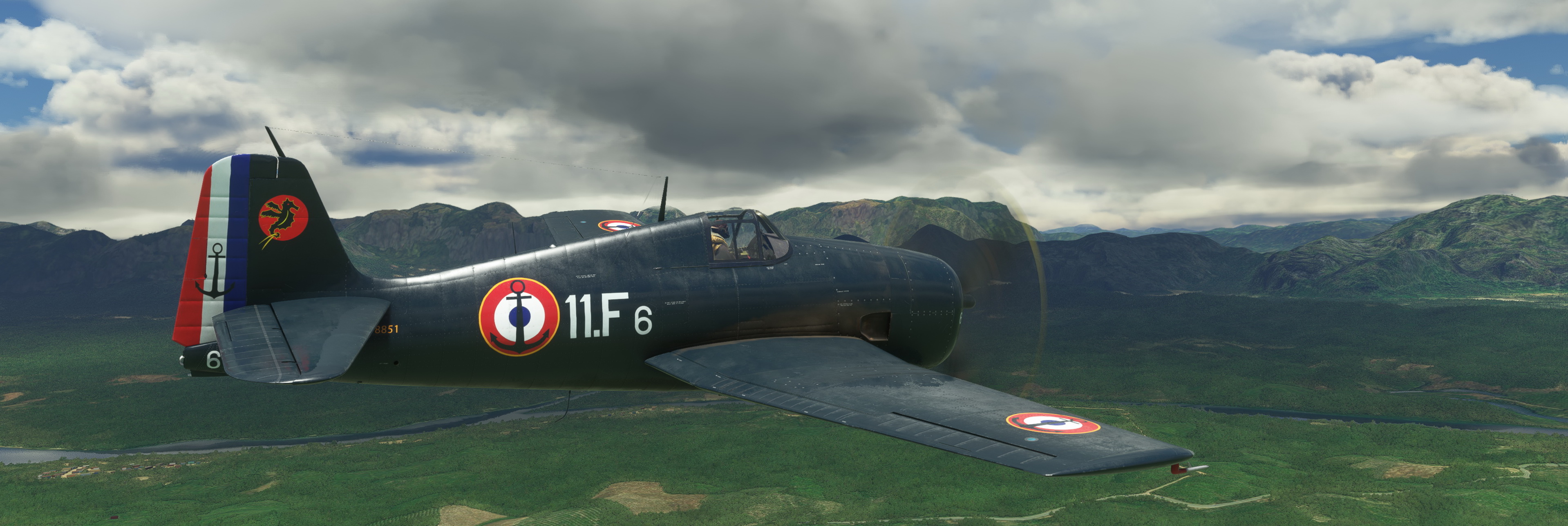Hi I am really enjoying this aircraft, even landings I find quite straightforward but take offs are a bit more challenging with the torque etc but not sure whether I need to pull back on the stick when I start TO run or just leave it “neutral” until the tail starts to lift? Any experiences appreciated!
I didn’t find take-offs hard at all. Did you set the tail wheel lock? It’s quite stable with that.
As for lifting the tail. It’s a bit hard to see, because a jet is in front of it, but this one takes off the runway with the tail still down. I don’t know if that’s best practice, though.
That Video here is really interesting and shows a takeoff. You can see that they don´t really lift the tail to a horizontal position. They nearly takeoff from a 3 point attidude.
At 09:20 they definitely lifted the tail first though?
Set 1.5 right rudder trim before takeoff
I wonder if it’s a matter of runway length or runway surface. Raising the tail should give you faster acceleration by reducing air resistance, while a tail down attitude might give you more stability during the take-off roll but results in a longer take off distance. And of course tail up allows for better visibility forward. in case that matters.
My understanding is that in modern practice three point takeoffs are rather common in warbirds to give extra clearance for the propeller, since you really don’t want it striking the ground. So it’s a good practice to include in your toolbox regardless what the wartime practice was.
Yeah, that’s a good point and the main advantage of tail draggers in the first place.
Regardless which takeoff method you use the stick is used to control the plane’s attitude. For two wheels you use the stick to keep the tail down at first, then lift the tail with the stick.
Yeah but not like in other Warbirds where you take the tail to the horizontal position. I guess the pilot did not put forward force on the stick. I guess he even pulled the stick a little back, to not raise the tail much more.
I do want to point out that, with the caveat I haven’t yet read the F6F POH, but, in normal operation these planes are designed to be flown with the cowl flaps closed, both to reduce drag, but, also, when open, the airflow through the engine can start to burble and stagnate and not cool the engine properly when the plane is at speed, since the airflow through the cowling is designed for the state when the cowl flaps are closed. They open mainly for ground operations, when the plane is not moving fast enough to move air through the cowling.
Also, these engines are set up so that it is possible to blow them out. They aren’t meant for personal use or safety. That way, when you just might need that little bit of extra to save your life, you can get it. It’s better to blow up an engine than lose a good pilot. The pilots are all trained for what the acceptable, and unacceptable, settings are up front. So, if you haven’t read the POH and training manuals in detail, don’t expect the plane to necessarily like you ![]()
I imagine most if not all of you know this, but, I hadn’t seen it stated explicitly.
Here’s another link to a F6F POH (probably the same as above) http://www.airwar.ru/other/manuals/[aviation]%20-%20[manuals]%20-%20F6F%20Pilots%20Handbook.pdf
I agree, that is what I based the changes I made to the engine.cfg file infact. @GotGravel mentioned that they do not affect temperatures but my testing shows otherwise. I encourage you to try the parameters I published above and report back. I might be biased since I spent two days tuning those with unhappy wife and kid, so any more would involve a divorce ![]()
None of this is actually used in the Hellcat. We use custom coding instead.
Not to mention forward visibility in the Hellcat is simply excellent for a taildragging warbird. A static deck angle of 7.5 degrees, downward sloping nose…this is in stark contrast with some other warbirds with long noses and 13 to 15 degrees of deck angle.
This was a also a highly admirable quality to have for carrier operations, making operating a Hellcat much safer than the Corsair.
Is the engine running too hot being recognized as a bug or it isn’t?
It will be looked into for an update.
 Screenshot (305) by JanKees Blom, on Flickr
Screenshot (305) by JanKees Blom, on Flickr
 Screenshot (302) by JanKees Blom, on Flickr
Screenshot (302) by JanKees Blom, on Flickr
 Screenshot (304) by JanKees Blom, on Flickr
Screenshot (304) by JanKees Blom, on Flickr
guys, would you add some buffeting stall and overspeed? and one more i found in this model you can catch negative aoa spin but aircraft stay not inverted. but if aircraft can brake critical negative aoa and go spin with that it should make aggressive negative half loop and spin inverted. i don’t sure but if i do recover from spin only by pull the stick it’s told about overcritical negative aoa, that’s have to push aircraft to legs up. did you add some custom aerodynamic codes?
Here you go fellow Hellcat pilots. Found this old instructional video to be really helpful.
do you know, why before dive there advice about left ruder trim tab(2*) i mean, what the hell will push hellcat right?

